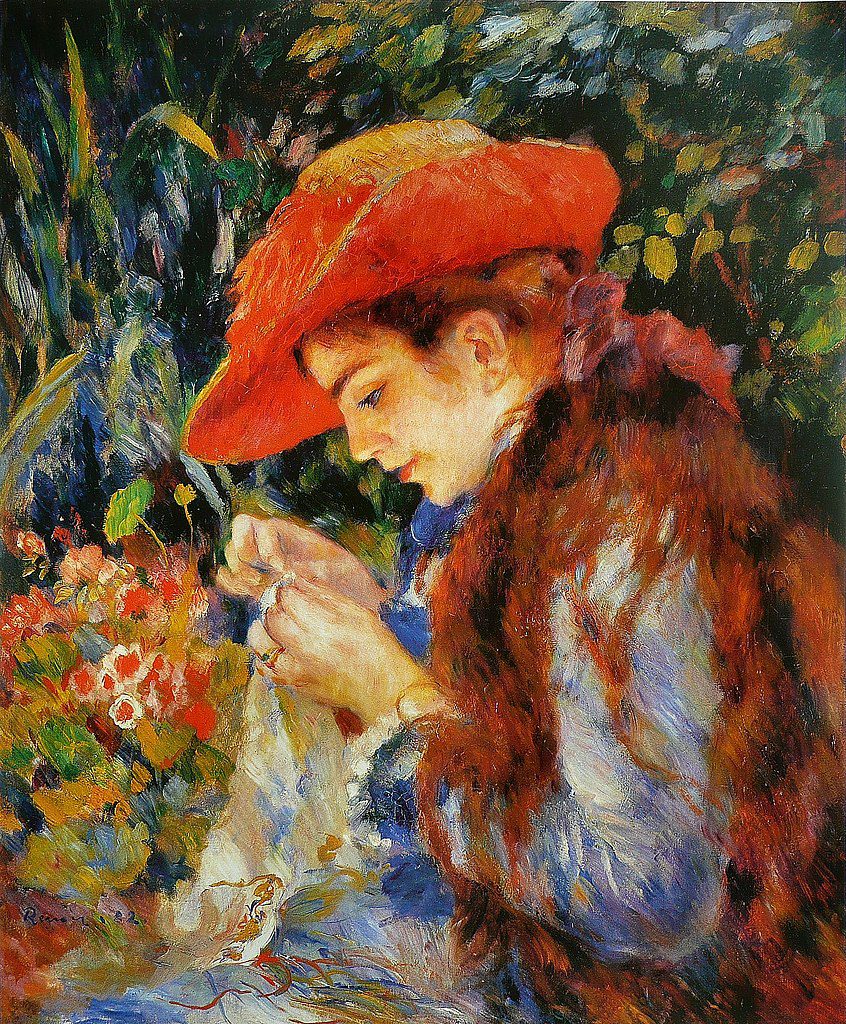
The world of art is rich with stories of muses who, with their charm and beauty, inspired timeless works. Among them, Marie-Thérèse Durand-Ruel holds a special place. Daughter of the renowned art dealer Paul Durand-Ruel, she was not only an important figure in the Impressionist art circle but also served as a captivating subject for Pierre-Auguste Renoir. Her presence on Renoir’s canvases provided him with an avenue to explore soft, romantic themes that are still admired by art enthusiasts and scholars today. As the daughter of an art dealer, she was immersed in a world that celebrated and nurtured creativity, and her relationship with Renoir reflects a fascinating blend of personal and professional connections.
The Background of Paul Durand-Ruel and His Influence on Art
Paul Durand-Ruel was not just an art dealer but a pioneering figure in the world of Impressionism. He is often credited with saving the Impressionist movement by providing financial and promotional support to artists such as Claude Monet, Édouard Manet, and Pierre-Auguste Renoir. Durand-Ruel’s approach to art dealing was revolutionary; he believed in acquiring works by emerging artists and supporting them, a practice that transformed the traditional art market. His commitment allowed Impressionism to flourish in an era when it faced significant opposition from conservative art institutions.
Marie-Thérèse, as Durand-Ruel’s daughter, grew up surrounded by creativity and art, absorbing an understanding of artistic aesthetics from a young age. Her proximity to this world and her father’s role in it naturally led her to become acquainted with prominent artists, especially Renoir, whose works she eventually came to personify on canvas.
Renoir’s Artistic Style and His Fascination with Marie-Thérèse
Pierre-Auguste Renoir’s style was defined by his focus on light, color, and the delicate portrayal of human beauty. Known for his vibrant, impressionistic brushstrokes, Renoir had a unique ability to capture the essence of his subjects, particularly women. Renoir’s paintings of Marie-Thérèse exhibit his mastery in using soft colors and warm tones to evoke a sense of intimacy and innocence. She embodied an ideal of femininity that Renoir often sought to portray—a sense of youth, gentleness, and grace that brought out his distinctive artistic sensibilities.
Marie-Thérèse became one of Renoir’s favorite models, and her features are immortalized in several of his pieces. Renoir’s fascination with her was not solely based on her beauty; rather, it was also her unique position as the daughter of his patron, which added layers of mutual respect and admiration to their relationship. This dynamic lent a certain depth to his portraits of her, as Renoir was capturing not just a beautiful woman but also a figure who symbolized a supportive relationship in the world of Impressionist art.
Iconic Paintings of Marie-Thérèse Durand-Ruel
Renoir painted Marie-Thérèse in several pieces, but each portrait captures a different facet of her personality and presence. One of the most notable works featuring her is “Portrait of Marie-Thérèse Durand-Ruel,” a piece that showcases her in a seated pose, with her face angled slightly away from the viewer. The portrait is delicate, marked by Renoir’s characteristic soft focus and subtle coloring, which accentuates her refined, almost ethereal appearance.
Renoir’s depiction of Marie-Thérèse often captures her in a serene, contemplative state, with her gaze cast downward or to the side. This subtle positioning draws the viewer’s attention to her gentle features, framed by Renoir’s rich color palette. Through these works, Renoir was not only celebrating Marie-Thérèse’s beauty but also honoring her family’s significant role in the Impressionist movement. Each painting of Marie-Thérèse can be seen as a tribute to the Durand-Ruel legacy, blending artistic merit with personal sentiment.
The Muse-Artist Relationship Between Renoir and Marie-Thérèse
The relationship between Marie-Thérèse Durand-Ruel and Renoir was one marked by mutual respect, artistic curiosity, and admiration. Unlike romanticized notions of artist-muse relationships that are often filled with drama, their connection was grounded in a professional and respectful friendship. Renoir’s depictions of Marie-Thérèse often show her as poised, graceful, and unassuming, reflecting not only her personality but also the respectful tone of their interactions.
For Renoir, Marie-Thérèse represented a living connection to one of his greatest supporters—her father, Paul Durand-Ruel. This connection provided him with not only a model but also an extension of his appreciation for the Durand-Ruel family’s support of his work. Through his portraits, Renoir offered Marie-Thérèse a kind of timeless presence, capturing her elegance while honoring her family’s commitment to the Impressionist cause.
How Marie-Thérèse Durand-Ruel Shaped Renoir’s Body of Work
Marie-Thérèse’s impact on Renoir’s work is significant because she provided him with a subject that combined beauty with an almost ethereal simplicity. Her portraits diverge from the grand, formalized depictions of nobility and instead embody an accessible, soft, and inviting presence. These qualities aligned with Renoir’s artistic goals, allowing him to create works that felt both refined and intimate.
The portraits of Marie-Thérèse reveal a subtler, more introspective side of Renoir’s artistry. Known for his lively depictions of social gatherings and scenes of leisure, Renoir’s works featuring Marie-Thérèse demonstrate a more contemplative tone. This shift in style speaks to Marie-Thérèse’s unique influence on his creative process, offering him a space to explore subdued beauty and quieter emotions.
The Legacy of Marie-Thérèse in Impressionist Art
Although Marie-Thérèse Durand-Ruel may not be as widely recognized as Renoir or Monet, her legacy within the Impressionist movement remains invaluable. Her image serves as a testament to the Durand-Ruel family’s indispensable contributions to art. Through her role as Renoir’s muse, Marie-Thérèse played a part in bringing to life some of his most cherished works. Her portraits serve as enduring symbols of the partnership between artists and patrons, a dynamic that often determines the survival and growth of art movements.
The legacy of Marie-Thérèse within Impressionism is also intertwined with the broader recognition of the critical role that patrons like her father played. By posing for Renoir, she brought a personal element to this legacy, embodying the very spirit of support and artistic freedom that her father championed for so many artists.
Renoir’s Reflections on Marie-Thérèse Durand-Ruel
Renoir’s relationship with Marie-Thérèse allowed him to explore new aspects of portraiture. His reflections on his time spent painting her reveal his appreciation for her quiet elegance. Renoir is known to have said that beauty was not just in the appearance of his subjects but in their character, a sentiment that undoubtedly applied to Marie-Thérèse. He valued her presence not only as a model but as an inspiring figure within his artistic circle.
Marie-Thérèse was not a conventional muse; her elegance was understated, yet Renoir found this quality to be endlessly inspiring. He viewed her not only as a beautiful woman but as a symbol of refined simplicity. This perspective influenced how he painted her and how her portraits ultimately fit into his larger body of work, which celebrated the beauty of everyday life.
The Importance of Marie-Thérèse Durand-Ruel Today
Today, Marie-Thérèse Durand-Ruel’s portraits are appreciated not just for their aesthetic beauty but for their historical significance. Art historians view her as a crucial figure who personifies the impact of patrons like her father in the art world. These paintings are studied and admired in museums and art institutions worldwide, offering modern audiences a glimpse into the collaborative spirit that defined the Impressionist movement.
Marie-Thérèse’s legacy has grown beyond her portraits; she is celebrated as part of a lineage that fostered creativity and innovation. Her image continues to inspire both viewers and artists, serving as a reminder of the power of art to transcend time and space. In a world where muses often fade into the background, Marie-Thérèse stands as a testament to the quiet, enduring impact a muse can have on an artist’s legacy.
Conclusion
Marie-Thérèse Durand-Ruel’s role as Renoir’s muse is a story of beauty, support, and artistic inspiration. As the daughter of Paul Durand-Ruel, her life was intertwined with the development of Impressionism, and her portraits stand as enduring symbols of this transformative era in art. Through Renoir’s paintings, Marie-Thérèse’s presence transcends her time, embodying the grace and simplicity that marked Renoir’s unique style. She is a reminder of how art can capture the essence of an era and the individuals who helped shape it.
Key Takeaways
- Marie-Thérèse Durand-Ruel was the daughter of influential art dealer Paul Durand-Ruel.
- Renoir’s portraits of Marie-Thérèse embody a blend of beauty, simplicity, and grace.
- The relationship between Marie-Thérèse and Renoir was professional, reflecting mutual respect.
- Her portraits are considered valuable parts of Impressionist art, symbolizing artistic support.
- Marie-Thérèse’s legacy continues to inspire admiration within the world of art.
FAQs
- Who was Marie-Thérèse Durand-Ruel?
Marie-Thérèse was the daughter of Paul Durand-Ruel, an influential art dealer and patron of Impressionism. - How did Marie-Thérèse become Renoir’s muse?
Her close connection to the art world through her father led her to meet Renoir, who found inspiration in her serene beauty. - Why are Renoir’s paintings of Marie-Thérèse significant?
These works highlight the role of patrons in the success of Impressionism and capture the delicate beauty Renoir admired. - What is Marie-Thérèse’s legacy in Impressionism?
She is remembered as both a muse and a symbol of the support that helped the Impressionist movement thrive.




